|
Base Layout
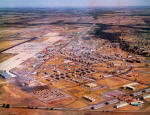 “You
had wing headquarters up by the flagpole. The hospital area was up in
the southeast corner. Then the shops were down at the north end of
Grayson Drive on the west side. The commissary was down in that area.
The sewage disposal plan was down there. The refueling for the
airplanes. Base supply.” Overton E. Jay (1951-1971) “You
had wing headquarters up by the flagpole. The hospital area was up in
the southeast corner. Then the shops were down at the north end of
Grayson Drive on the west side. The commissary was down in that area.
The sewage disposal plan was down there. The refueling for the
airplanes. Base supply.” Overton E. Jay (1951-1971)
 “The
barracks were two story. They were open bays. The bottom, as you went in
from the back end, to the right was the latrine and to the left was the
heating area where they had the furnace. When you went past those, that
was about twenty feet in, then it became all open. Everyone slept in a
bunk with a footlocker at the bottom and a small locker where you’d hang
your clothes. It had wood floors.” Ken Hayes (1953-1971) “The
barracks were two story. They were open bays. The bottom, as you went in
from the back end, to the right was the latrine and to the left was the
heating area where they had the furnace. When you went past those, that
was about twenty feet in, then it became all open. Everyone slept in a
bunk with a footlocker at the bottom and a small locker where you’d hang
your clothes. It had wood floors.” Ken Hayes (1953-1971)
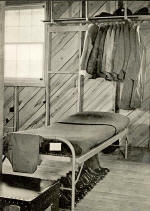 “There
were two rows of bunks separated by a middle aisle, and there were
probably twenty bunks on each side of the aisle. They were wooden
barracks with staggered beds. One head was one way and the other head
was the next way, and that was about it. Certainly nothing fancy. We had
our footlocker at the foot of the bed. We had a tiny place to hang our
uniforms. They were not enclosed in a locker. They were just a rod along
the side of the windows.” Bill Teague (1942-1945) “There
were two rows of bunks separated by a middle aisle, and there were
probably twenty bunks on each side of the aisle. They were wooden
barracks with staggered beds. One head was one way and the other head
was the next way, and that was about it. Certainly nothing fancy. We had
our footlocker at the foot of the bed. We had a tiny place to hang our
uniforms. They were not enclosed in a locker. They were just a rod along
the side of the windows.” Bill Teague (1942-1945)
 “The
brick barracks was air-conditioned. The other wood barracks buildings,
you opened the windows and hoped for a breeze. The brick barracks had
metal wall lockers, solid bunks, tile floors. It was pretty nice.”
Ralph Waterloo (1963-66) “The
brick barracks was air-conditioned. The other wood barracks buildings,
you opened the windows and hoped for a breeze. The brick barracks had
metal wall lockers, solid bunks, tile floors. It was pretty nice.”
Ralph Waterloo (1963-66)
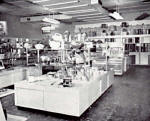 “The
Post Exchange was a converted building in World War II style. It had two
wings to it. You could buy mostly military type clothing and cosmetics,
toothbrushes, that sort of thing. You could buy just about anything in
there that you could buy at some of the local clothing stores, drug
stores, all kind of combined.” Col. B. J. Long (1950-1962). “The
Post Exchange was a converted building in World War II style. It had two
wings to it. You could buy mostly military type clothing and cosmetics,
toothbrushes, that sort of thing. You could buy just about anything in
there that you could buy at some of the local clothing stores, drug
stores, all kind of combined.” Col. B. J. Long (1950-1962).
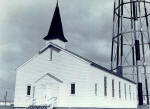 “As you
go in on the Boulevard, at the end there was a water tower, and
headquarters was just below that and the chapel was right behind it. My
daughter was married in that chapel, when I came back from Vietnam.”
Col. B. J. Long (1950-1962) “As you
go in on the Boulevard, at the end there was a water tower, and
headquarters was just below that and the chapel was right behind it. My
daughter was married in that chapel, when I came back from Vietnam.”
Col. B. J. Long (1950-1962)
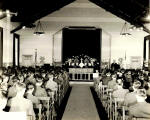 “Of
course, we only had one building, but we had different configurations of
the building for each of the three major religions, and it was—not only
mine, but the other Chaplain’s Assistants, also—our responsibility to
see that the building was ready for whatever service we had coming up.”
Bill Teague (1942-1945) “Of
course, we only had one building, but we had different configurations of
the building for each of the three major religions, and it was—not only
mine, but the other Chaplain’s Assistants, also—our responsibility to
see that the building was ready for whatever service we had coming up.”
Bill Teague (1942-1945)
 “The
hangars are on the west side of Grayson Drive. Out in front of the
hangars to the west was . . . I think they call it a tarmac now; we
called it an apron then, where they parked the airplanes. I was working
on survey, and we laid out the apron; we laid out the hangars; we laid
out the taxiways and the runways and the streets. All that. The power
poles, buildings, and all.” Overton
E. Jay (1951-1971) “The
hangars are on the west side of Grayson Drive. Out in front of the
hangars to the west was . . . I think they call it a tarmac now; we
called it an apron then, where they parked the airplanes. I was working
on survey, and we laid out the apron; we laid out the hangars; we laid
out the taxiways and the runways and the streets. All that. The power
poles, buildings, and all.” Overton
E. Jay (1951-1971)
 “Down
at the north end, there’s a hangar building sitting up there on the
runway. That was the alert hangar. We had pilots up there like a fire
station, 24 hours a day. We had F-86s and 102s, later, in those hangars,
and just like a fire, if they called an alert, they’d send those
airplanes up.” James McCall
(1951, 1956-1971) “Down
at the north end, there’s a hangar building sitting up there on the
runway. That was the alert hangar. We had pilots up there like a fire
station, 24 hours a day. We had F-86s and 102s, later, in those hangars,
and just like a fire, if they called an alert, they’d send those
airplanes up.” James McCall
(1951, 1956-1971)
“We had a big operation here for the size of the base. Basically, it
was the equivalent of several squadrons. We were a wing, but we had more
equipment, more airplanes and more pilots than the average base.”
Col. B. J. Long (1950-1962)
Perrin Aircraft
 |
